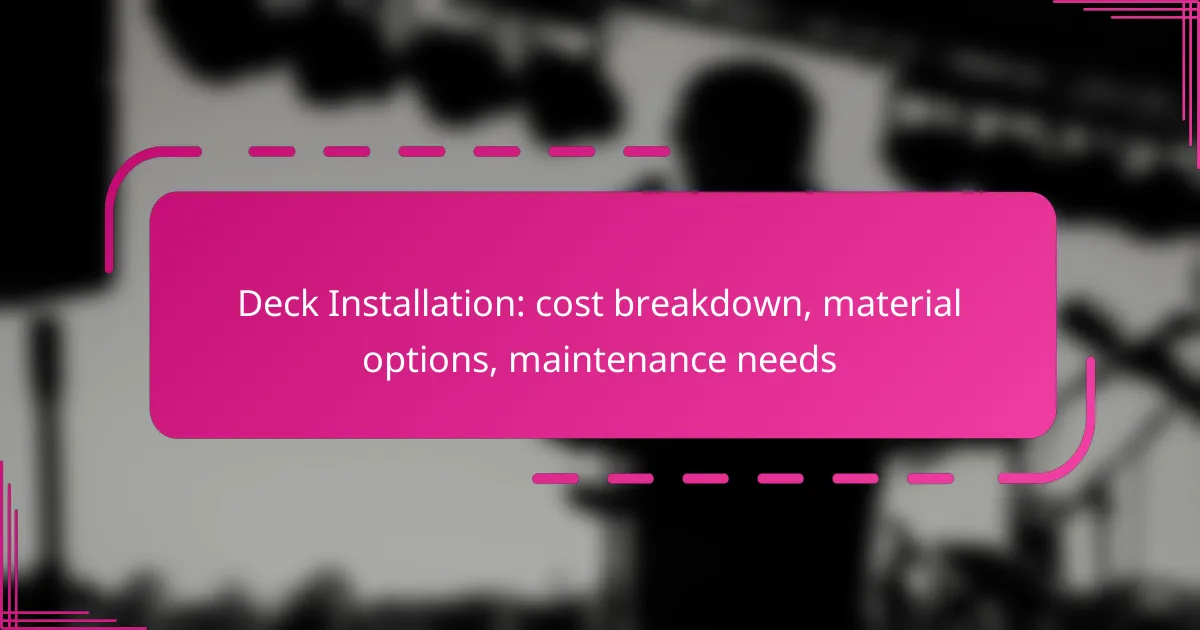When planning a deck installation, homeowners should be aware of the average costs, which can range from several thousand to over ten thousand dollars, influenced by material choices and size. A variety of materials, including wood, composite, and aluminum, offer distinct advantages in terms of aesthetics, durability, and maintenance requirements. Understanding these factors is crucial for making an informed decision that balances initial investment with long-term upkeep.

What is the average cost of deck installation in the United States?
The average cost of deck installation in the United States typically ranges from several thousand to over ten thousand dollars, depending on materials and size. Homeowners should consider both the initial installation costs and long-term maintenance when budgeting for a deck.
Cost range for wood decks
Wood decks generally cost between $15 and $30 per square foot, including materials and labor. Pressure-treated lumber is often on the lower end of this range, while premium hardwoods like cedar or redwood can push costs higher.
When choosing wood, consider the longevity and maintenance needs. Softwoods may require more frequent sealing and staining, while hardwoods can last longer with proper care.
Cost range for composite decks
Composite decks typically range from $20 to $40 per square foot, depending on the quality of the materials used. Higher-end composites may include additional features like fade resistance and enhanced durability, which can justify the higher price.
Composite materials often require less maintenance than wood, making them a popular choice for homeowners looking for longevity without the hassle of regular upkeep.
Factors affecting installation costs
Several factors can influence the overall cost of deck installation, including the size of the deck, the complexity of the design, and local labor rates. Larger decks or those with intricate designs will naturally cost more due to increased material and labor requirements.
Additionally, regional differences in labor costs can significantly impact the total price. Areas with higher living costs may see elevated installation fees, so it’s wise to obtain multiple quotes from local contractors.

What materials are available for deck installation?
Deck installation offers a variety of materials, each with unique characteristics and benefits. The most common options include wood, composite materials, and aluminum, allowing homeowners to choose based on aesthetics, durability, and maintenance needs.
Wood options for decks
Wood is a traditional choice for decking, known for its natural beauty and warmth. Common types include pressure-treated lumber, cedar, and redwood, each offering different levels of durability and resistance to decay.
When selecting wood, consider factors like climate and exposure to moisture. Pressure-treated wood is often more affordable but requires regular sealing and staining to maintain its appearance and longevity.
Maintenance typically involves annual cleaning and reapplication of protective finishes. Expect to spend around $15 to $30 per square foot for installation, depending on the wood type and local labor costs.
Composite materials for decks
Composite decking is made from a blend of wood fibers and plastic, providing a low-maintenance alternative to traditional wood. It resists fading, staining, and mold, making it ideal for areas with high humidity or heavy foot traffic.
While composite materials can be more expensive upfront, typically ranging from $20 to $40 per square foot for installation, they often save money in the long run due to reduced maintenance needs.
Choose composite decking that has a good warranty and check for slip resistance, especially in wet climates. Regular cleaning with soap and water is usually all that’s needed to keep it looking good.
Aluminum decking options
Aluminum decking is a durable and lightweight option that offers excellent resistance to weather, insects, and rot. It is non-combustible and can be a great choice for areas prone to wildfires or extreme weather conditions.
Installation costs for aluminum decking can range from $25 to $50 per square foot, making it one of the pricier options. However, its longevity and minimal maintenance requirements can offset the initial investment.
Consider aluminum decking if you want a long-lasting solution that requires little upkeep. Regular cleaning with a mild detergent is sufficient to maintain its appearance, and it often comes with warranties that reflect its durability.

What are the maintenance needs for different deck materials?
Different deck materials have varying maintenance requirements that can significantly impact their longevity and appearance. Understanding these needs helps homeowners choose the right material and plan for upkeep effectively.
Maintenance for wood decks
Wood decks require regular maintenance to prevent rot, warping, and insect damage. This typically includes cleaning, sealing, and staining every one to three years, depending on the climate and wood type.
To maintain a wood deck, homeowners should inspect for loose boards or nails and address any issues promptly. A simple cleaning routine with a mild detergent and water can help keep the surface looking fresh.
Maintenance for composite decks
Composite decks are generally low-maintenance compared to wood, requiring only occasional cleaning with soap and water to remove dirt and debris. They do not need staining or sealing, which can save time and costs over the years.
However, it’s important to avoid using harsh chemicals or pressure washing, as these can damage the surface. Regularly checking for any loose boards or fasteners can help maintain safety and aesthetics.
Maintenance for aluminum decks
Aluminum decks are among the easiest to maintain, as they are resistant to rust, rot, and insect damage. A simple wash with soap and water is usually sufficient to keep them in good condition.
While they don’t require sealing or painting, it’s wise to inspect the deck periodically for any signs of wear or damage, particularly at joints and connections. Keeping the surface clear of debris will also help maintain its appearance and functionality.

How do I choose the right deck material for my home?
Choosing the right deck material involves considering factors such as climate, budget, and durability. Each material has its own advantages and disadvantages, so understanding these aspects will help you make an informed decision that suits your home and lifestyle.
Considerations for climate
Your local climate significantly impacts the best deck material for your home. For example, in areas with high humidity, like the Southeastern United States, materials resistant to moisture, such as composite or PVC decking, are ideal. Conversely, in dry, hot climates, natural woods like cedar or redwood may be more suitable, as they can withstand the heat better than some synthetics.
Additionally, consider the temperature fluctuations in your region. Materials that expand and contract with temperature changes, such as certain composites, may perform better in regions with significant seasonal variations.
Budget considerations
Budget is a crucial factor when selecting deck materials. Natural wood options like pressure-treated pine are generally more affordable, often ranging from $15 to $30 per square foot, including installation. In contrast, composite and PVC materials can cost between $30 and $60 per square foot, but they often require less maintenance over time.
When budgeting, factor in long-term costs, such as maintenance and potential replacement. While cheaper materials may save you money upfront, they might incur higher maintenance costs, making them more expensive in the long run.
Durability and lifespan factors
Durability varies widely among deck materials. Pressure-treated wood typically lasts around 10 to 15 years, while high-quality composites and PVC can last 25 years or more with minimal upkeep. Consider how much wear and tear your deck will experience based on usage and environmental conditions.
Additionally, think about the maintenance requirements of each material. Natural woods often need regular sealing and staining, while composite and PVC options usually require only occasional cleaning. This can influence both the time and money you invest in your deck over its lifespan.

What are the local regulations for deck installation?
Local regulations for deck installation vary significantly by location and typically include building codes, permitting requirements, and homeowner association (HOA) rules. Understanding these regulations is crucial to ensure compliance and avoid potential fines or project delays.
Building codes in California
California’s building codes for deck installation focus on safety and structural integrity, particularly due to seismic activity in the region. Decks must adhere to the California Building Code (CBC), which outlines requirements for materials, load capacities, and construction practices.
Homeowners should consult local building departments to obtain specific guidelines, as cities may have additional regulations. For example, decks must often be constructed with treated wood or other durable materials to withstand the state’s climate and pests.
Permitting requirements in Texas
In Texas, the need for a permit when installing a deck largely depends on the size and height of the structure. Generally, decks that are more than 30 inches above ground level or cover a significant area will require a permit. It’s essential to check with local authorities for specific requirements.
Obtaining a permit involves submitting plans that detail the deck’s design, materials, and dimensions. Failure to secure a permit can result in fines and the need to dismantle the deck, so homeowners should ensure compliance before starting construction.
HOA regulations in Florida
In Florida, many neighborhoods are governed by homeowner associations (HOAs) that impose specific regulations on deck installation. These rules can dictate the materials used, the design aesthetics, and even the placement of the deck on the property.
Homeowners should review their HOA guidelines before beginning any deck project. Common restrictions may include limitations on height, color, and proximity to property lines. Engaging with the HOA early in the planning process can help avoid conflicts and ensure a smoother approval process.

What are the emerging trends in deck design?
Emerging trends in deck design focus on sustainability, technology integration, and aesthetic versatility. Homeowners are increasingly seeking eco-friendly materials and smart features that enhance functionality while maintaining visual appeal.
Sustainable materials in decking
Sustainable materials are gaining popularity in deck construction due to their environmental benefits and durability. Options like composite decking, made from recycled plastics and wood fibers, offer longevity and reduced maintenance compared to traditional wood. Additionally, responsibly sourced hardwoods, such as bamboo or teak, are becoming favored choices for their renewability.
When selecting sustainable materials, consider factors like lifespan, maintenance requirements, and local availability. For instance, composite decking can range from $2 to $5 per linear foot, while sustainably sourced hardwoods may cost between $5 and $10 per linear foot. Always check for certifications like FSC (Forest Stewardship Council) to ensure responsible sourcing.
Smart technology integration
Smart technology is transforming deck design by adding convenience and enhancing outdoor living experiences. Features such as integrated lighting, automated shading systems, and wireless sound systems allow homeowners to customize their outdoor spaces easily. These technologies not only improve usability but can also increase property value.
When incorporating smart technology, consider the installation costs and compatibility with existing systems. Basic smart lighting can start around $50 per fixture, while more complex setups with automated controls may run into the low thousands. Ensure that any electrical work complies with local building codes and regulations to avoid safety issues.
